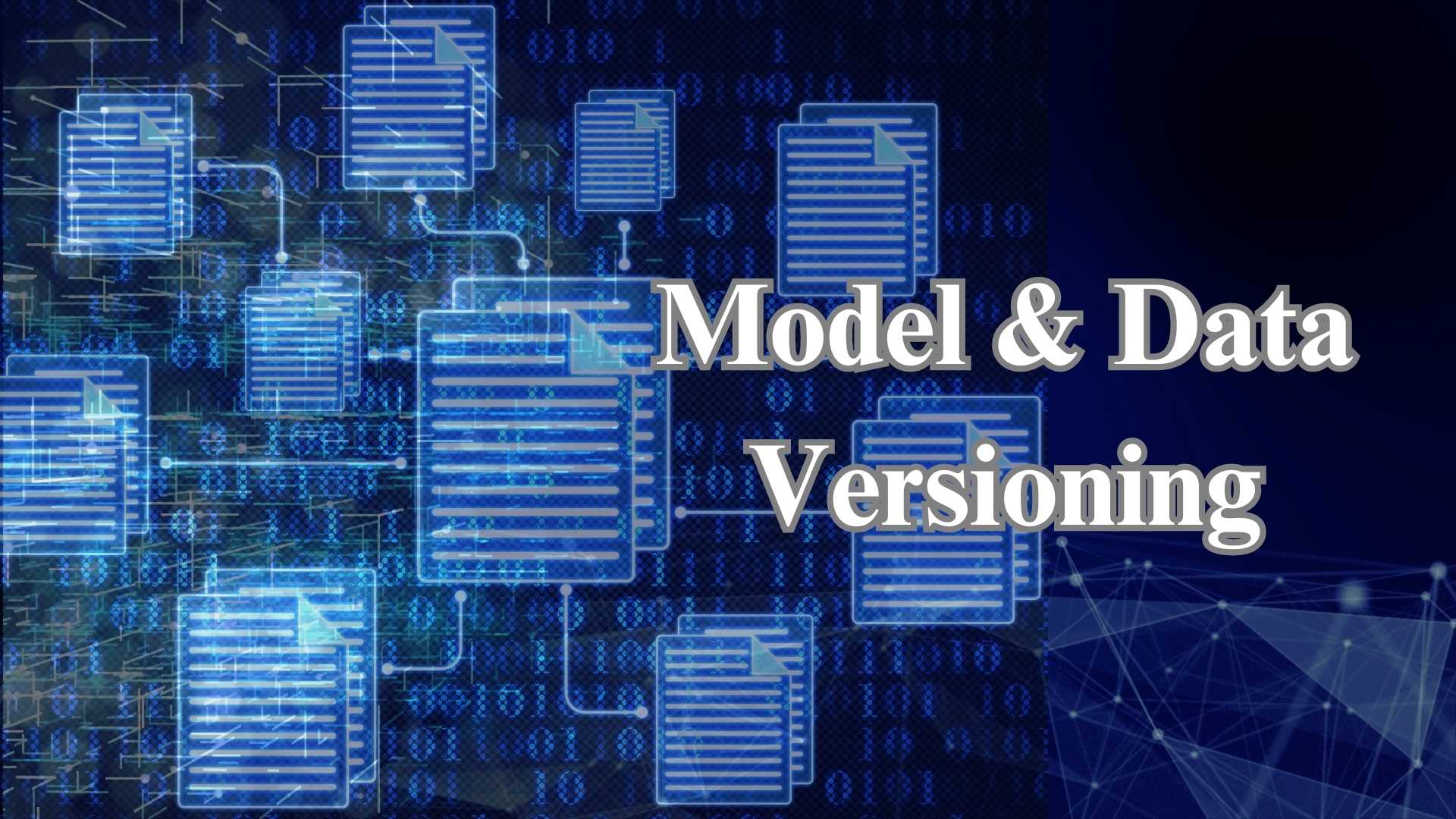Machine learning models rely on versioning data reproducibility to ensure consistent performance and accuracy over time. By tracking changes in data and model versions, organizations can maintain transparency and traceability, facilitating collaboration and troubleshooting. This practice promotes reliability and confidence in machine learning systems, fostering innovation and progress in various domains.
Vital Necessity: Versioning Machine Learning Models
In the ever-evolving world of Machine Learning (ML), a crucial factor for success is reproducibility. The ability to replicate the results of an ML experiment independently is essential for various reasons:
- Validation:
Ensure the validity and reliability of the model’s performance.
- Reproducibility: Versioning allows you to recreate the exact conditions under which the model was trained and evaluated, enabling the validation of its performance across different environments and settings. This helps ensure the results are not specific to a single data sample or configuration and generalizes well to unseen data.
- Debugging and improvement:
Diagnose issues, troubleshoot performance degradation, and make informed optimizations.
- Traceability: By tracking changes made to both data and models through versioning, you can pinpoint the specific version that led to performance degradation. This facilitates targeted troubleshooting by allowing you to compare different versions and identify the source of the issue.
- Experiment comparison: Versioning facilitates the comparison of performance metrics acquired from various data and model versions. Consequently, this aids in identifying enhancements or regressions, empowering data scientists to make informed decisions regarding hyperparameter tuning, feature engineering, or model selection.
- Collaboration and knowledge sharing:
To enable seamless collaboration between team members and facilitate the sharing of knowledge and best practices.
- Clarity and consistency: Versioning ensures everyone on the team is working with the same version of data and models, eliminating confusion and facilitating clear communication. This promotes collaboration by establishing a common ground for discussions and knowledge sharing.
- Reproducible results: Moreover, by sharing specific versions of data and models, team members can easily replicate each other’s work and build upon successful experiments. This accelerates progress and facilitates knowledge transfer within the team.
- Version control history: Versioning provides a historical record of changes, allowing team members to understand the evolution of the model and data, promoting knowledge sharing, and facilitating the onboarding of new team members.
A key element in achieving reproducibility involves versioning, the practice of tracking and managing different versions of both data and models used throughout the ML lifecycle. This chapter delves into the importance of versioning for ensuring reproducible ML pipelines and discusses practical strategies for implementing it effectively.
Challenges of Non-Versioned ML Pipelines:
Without proper versioning, several challenges arise that hinder the development and deployment process of robust ML models:
- Difficulty in tracking changes: It becomes difficult to understand what changes were made to the data or model, and when, leading to confusion and potential errors.
- Inability to reproduce results: Replicating the exact experimental setup and results becomes challenging without a clear record of all used versions.
- Increased risk of regressions: Introducing changes to the data or model without versioning can lead to unintended regressions that are difficult to identify and revert.
- Hindered collaboration: Collaboration suffers when team members are unsure about which versions of data and models are being used, leading to potential inconsistencies and confusion.
Enhancing Performance: Versioning Machine Learning Models
Implementing a robust versioning strategy offers numerous benefits for ensuring reproducible and reliable ML workflows:
- Improved traceability: Versioning provides a clear audit trail, allowing you to track changes made to data and models over time, facilitating debugging, and understanding how changes impacted the results.
- Reproducibility: By precisely identifying specific versions of data and models used in a successful experiment, you can effortlessly recreate the same conditions and ensure consistent results.
- Rollbacks and experimentation: Versioning empowers you to easily revert to previous versions of data or models in case of performance regressions or unexpected behavior, allowing for safe experimentation and iteration.
- Enhanced collaboration: Versioning facilitates seamless collaboration by enabling team members to work with specific versions of data and models while maintaining clarity and avoiding confusion.

Machine Learning Models: Progressive Versioning Solutions
Several approaches can be adopted to effectively version data and models in an ML pipeline:
1. Data Versioning:
Data versioning involves creating and managing distinct versions of your data throughout the process. Here are some common techniques:
- File systems with version control: Utilizing systems like Git or Subversion allows you to track changes to data files, enabling rollbacks and comparisons between different versions.
- Database versioning: Many databases offer built-in versioning capabilities, allowing you to create data snapshots at specific points in time and revert to previous states if needed.
- Data lineage tools: Utilizing specialized data lineage tools helps track the source, transformations, and changes applied to the data. This facilitates understanding the impact of data changes on model performance.
Best Practices for Data Versioning:
- Utilize Version Control Systems: Implement tools like Git or Subversion to track changes to data files, enabling rollbacks and comparisons between different versions.
- Leverage Database Versioning Features: If your data resides in a database, explore its built-in versioning capabilities. This allows you to create snapshots of data at specific points in time, facilitating easy rollback to previous states.
- Employ Data Lineage Tools: Use dedicated tools to track the origin, transformations, and changes applied to the data. This promotes an understanding of how data manipulation affects model performance and facilitates debugging.
- Maintain Consistent Naming Conventions: Establish clear and consistent naming schemes for different versions of your data files. This promotes organization and simplifies the identification of specific versions.
- Implement Data Lifecycle Management: Develop a strategy for archiving and purging older data versions. This helps manage storage space while ensuring compliance with data governance regulations.
2. Model Versioning:
Model versioning encompasses managing and tracking different versions of your trained ML models:
- File-based versioning: Saving each trained model as a separate file with version identifiers helps track and compare different model iterations.
- Model registry tools: Dedicated model registry tools such as MLflow or Kubeflow Model Registry offer centralized storage and management of models. Additionally, they provide versioning capabilities and metadata tracking.
- Containerization: Utilizing containerization technologies like Docker enables you to package and deploy models as individual units, ensuring consistency and reproducibility across environments.
Best Practices for Model Versioning:
- Utilize dedicated model registry tools: Implement tools like MLflow or Kubeflow Model Registry for centralized storage, management, and versioning of models. These tools offer features like version control, metadata tracking, and access control, streamlining the process.
- Leverage containerization: Furthermore, consider containerization technologies such as Docker for packaging and deploying models as self-contained units. This approach ensures consistency and reproducibility across environments by bundling model code, dependencies, and configuration together.
- Maintain clear versioning & naming conventions: Establish a clear and consistent naming convention for your models, incorporating version information and potentially reflecting the purpose or specific changes made (e.g., “model_v1.2_improved_accuracy”). This aids in easy identification and differentiation between versions.
- Integrate seamlessly into CI/CD pipelines: Integrate model versioning with your CI/CD pipeline to automate the process of capturing and storing different model iterations as they are built and deployed. This ensures version control and facilitates easy rollback or comparison when needed.
- Implement access control and governance: Moreover, establish access control mechanisms within your model registry or platform to manage permissions for different users and roles. Consequently, this ensures proper governance, prevents unauthorized access, and allows for controlled deployment of models.
3. Versioning Frameworks and Tools:
Several frameworks and tools specifically cater to data and model versioning in ML pipelines:
- Git: A popular version control system widely used to manage code changes. It can effectively be used for versioning data files like CSV or JSON.
- DVC (Data Version Control): Built on top of Git, DVC facilitates the versioning of large datasets and integrates seamlessly with ML pipelines.
- MLflow: An open-source platform for managing the ML lifecycle, including model versioning, tracking experiments, and deployment.
- Kubeflow Model Registry: A registry specifically designed for managing and deploying Machine Learning models with features for versioning, lineage tracking, and access control.
Best Practices for Versioning Frameworks and Tools:
- Choose the right tool: Evaluate your specific needs and choose a tool that aligns with your project complexity (e.g., Git for simpler projects, MLflow for complex pipelines).
- Utilize advanced features: Explore advanced functionalities offered by chosen tools, such as experiment tracking, model comparison, and collaboration features in platforms like MLflow.
- Integrate with existing infrastructure: Ensure compatibility of your chosen versioning tool with your existing development and deployment environment for seamless integration.
4. Integrating Versioning into the ML Pipeline:
Versioning should be seamlessly integrated into the entire ML pipeline for optimal efficacy. Here are key considerations for effective incorporation:
- Versioning data pipelines: Utilize tools like DVC or MLflow to version data pipelines, ensuring that the specific version of the pipeline used to generate the data is documented and can be reproduced.
- Capturing environment details: Capture and version the environment details used during training, including software versions (libraries, frameworks), hardware specifications, and configuration parameters. This ensures consistent results when reproducing the training process.
- Versioning experiments: Utilize experiment tracking tools that capture and version all aspects of an experiment, including data version, model version, hyperparameters, and performance metrics. This facilitates the comparison of different experiments and identifies the most successful configuration.
Best Practices for Integrating Versioning into the ML Pipeline:
- Version entire pipeline: Utilize tools like DVC or MLflow to version your entire data pipeline, including data processing steps, ensuring reproducibility of data generation.
- Track experiment details: Moreover, utilize experiment tracking tools to capture and version all experiment aspects such as hyperparameters, data versions, and performance metrics. This facilitates comprehensive analysis and comparison.
- Utilize containerization: Employ containerization tools like Docker to package your training environment, including dependencies and libraries, ensuring consistent execution across different deployments.
5. Considerations for Scalable Versioning:
As the volume of data and models grows, maintaining a scalable versioning strategy becomes crucial:
- Leveraging cloud storage: Utilize cloud storage solutions like Amazon S3 or Google Cloud Storage for efficiently storing and managing large datasets and model artifacts associated with different versions.
- Data lifecycle management: Implement a data lifecycle management strategy to archive older versions of data and models while ensuring compliance with regulations and data governance policies.
- Version pruning: Consider a strategy for automatically pruning outdated versions of data and models to optimize storage space and maintain efficient performance.
Best Practices for Considerations for Scalable Versioning:
- Leverage cloud storage: Utilize cloud storage solutions like S3 or Google Cloud Storage for efficient and scalable storage of large datasets and associated model versions.
- Implement data lifecycle management: Establish a data lifecycle management strategy to archive older versions of data and models while complying with data governance regulations and optimizing storage space.
- Automate version pruning: Consider automated pruning strategies that remove outdated versions based on defined criteria (e.g., age, usage), ensuring efficient storage utilization and maintaining system performance.
6. Managing Versioning Conflicts:
In collaborative environments, managing version conflicts can be crucial:
- Clear communication: Establish clear communication protocols within teams regarding the use and modification of specific versions of data and models.
- Branching and merging strategies: Employ branching and merging strategies in version control systems like Git to manage concurrent changes and prevent conflicts.
- Conflict resolution processes: Establishing clear guidelines is essential for resolving conflicts that may arise when multiple team members work on different versions of data or models.
Best Practices for Managing Versioning Conflicts:
- Establish clear communication protocols: Clearly define communication protocols within teams regarding the use and modification of specific versions of data and models to avoid confusion and conflicts.
- Utilize branching and merging strategies: Effectively utilize branching and merging strategies in version control systems like Git to manage concurrent changes. This helps in preventing conflicts and facilitating collaboration seamlessly.
- Define conflict resolution processes: Establish clear and documented processes for resolving conflicts that may arise between different versions, ensuring timely and efficient resolution.
Conclusion:
Versioning data and models plays a central role in ensuring reproducible, reliable, and collaborative ML development workflows. Moreover, by implementing a robust versioning strategy and employing tools and techniques effectively, you can facilitate efficient debugging, and iteration, and ultimately, build high-quality, well-documented, and trustworthy Machine Learning models.
Beyond the Basics:
- Federated Learning and Versioning: Explore the challenges and considerations for versioning data and models in federated learning scenarios where data remains decentralized across different entities.
- Continuous Integration and Continuous Delivery (CI/CD) for Versioning: Investigate how to integrate versioning practices seamlessly into CI/CD pipelines for streamlined and automated model deployment.
- Data Privacy and Versioning: Understand the complexities of balancing data privacy regulations with versioning requirements and consider anonymization or pseudonymization techniques when necessary.
FAQ’s:
1: Why is versioning important in machine learning?
Versioning ensures reproducibility by tracking changes to both data and models, facilitating validation, debugging, and collaboration among team members.
2: What are the challenges of not versioning ML pipelines?
Without versioning, it’s difficult to track changes, reproduce results, identify regressions, and collaborate effectively, hindering the development and deployment of robust Machine Learning models.
3: How can data versioning be implemented effectively?
Data versioning can be implemented through version control systems like Git, database versioning, or using data lineage tools. Clear naming conventions and data lifecycle management are also essential best practices.
4: What are the benefits of model versioning?
Model versioning allows for tracking different iterations of trained Machine Learning models, enabling reproducibility, experimentation, collaboration, and easy rollback in case of regressions or unexpected behavior.
5: How can versioning be integrated into the ML pipeline?
Versioning can be seamlessly integrated into the ML pipeline by versioning data pipelines, capturing environment details, tracking experiment details, utilizing containerization, and ensuring compatibility with CI/CD pipelines.









